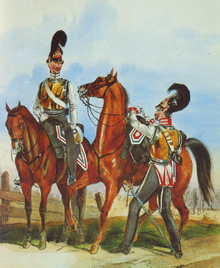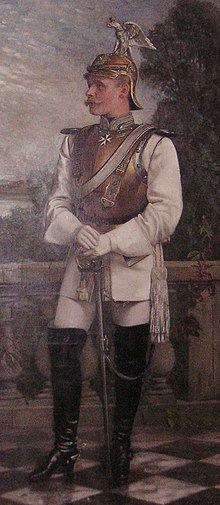Guard Cuirassier Regiment


The Guards Cuirassiers was a cavalry joined the Prussian army .
history
On February 21, 1815, King Friedrich Wilhelm III. the formation of the Guards Uhlan Regiment from the Guards Cossack Squadron and two squadrons of the Silesian National Cavalry Regiment. The federation was reclassified to cuirassiers in 1821 and was given the name Guard Cuirassier Regiment . The regiment was stationed in Berlin . In 1838 his barracks were at Feldstrasse 39 (today Alexandrinenstrasse, corner of Gitschiner Strasse, Berlin-Kreuzberg). Until the beginning of the First World War, it formed the 1st Guard Cavalry Brigade with the regiment of the Gardes du Corps .
German revolution
In 1848, the regiment was used on the occasion of the revolutionary unrest in street fighting in Berlin.
German-Danish War
In the campaign against Denmark of 1864 there was no mobilization for the regiment .
German war
In the war against the German Confederation in 1866, the regiment moved to Bohemia . It had its first contact with the enemy in the battle of Skalitz and later took part in the battle near Schweinschädel and the battle of Königgrätz . In September the regiment returned to Berlin.
Franco-German War
In the war against France in 1870/71 , the Guard Cuirassiers were in reserve in the battle of St. Privat . This was followed by skirmishes in the Sedan area and then participation in the Battle of Sedan on September 1, 1870. The following winter, the regiment was assigned to the siege force around Paris and returned to its garrison in June 1871.
First World War
After the mobilization, the regiment marched out on August 4, 1914 through Luxembourg and Belgium to northern France. After taking part in the Battle of the Marne, he retreated and, until December 1914, trench warfare on the Aisne .
From December 1914 to July 1915, he was deployed in border guards on the Belgian-Dutch border. From August 1915 he was transferred to the Eastern Front and participated in the offensive fighting in Russian Poland and Galicia . From October 1915 to February 1918 position battles near Pinsk and Kovel . Then relocation to Silesia , where the regiment finally lost its cavalry status and was converted to the Cavalry Rifle Regiment in the Association of the Guard Cavalry Rifle Division . After completion of the infantry training, the former cuirassiers were used in the defensive battles on the western front until the end of the war. The march back home began on November 10, 1918.
Whereabouts
On December 10, 1918, the regiment entered Berlin through the Brandenburg Gate , where demobilization then began. To put down the unrest in Berlin, three volunteer squadrons were formed from the remnants of the unit. One of them (Eskadron Bredow) was made mounted and fought against the Polish insurgents in the Baltic States , the other two were used in the street fights on the occasion of the Spartacus uprising in Berlin.
In September 1919, the remnants of the guard cuirassiers were formed into the Brandenburg Guard cuirassier squadron, and on November 1, 1919 it was incorporated into the 3rd Reichswehr Reiter Regiment .
The tradition took over in the Reichswehr by decree of the Chief of the Army Command General of the Infantry Hans von Seeckt from August 24th, 1921 the 2nd Squadron of the 4th (Prussian) Cavalry Regiment in Perleberg .
Commanders
| Rank | Surname | date |
|---|---|---|
| Major / Lieutenant Colonel / Colonel | August von Krafft | February 21, 1815 to September 23, 1830 |
| Major / Lieutenant Colonel / Colonel | Hans von Sydow | March 30, 1832 to February 7, 1840 |
| Colonel | August of Württemberg | February 8, 1840 to March 30, 1844 |
| Lieutenant Colonel / Colonel | Ferdinand von Bischoffwerder | March 30, 1844 to October 14, 1848 |
| Major / Lieutenant Colonel / Colonel | Adolf Lauer von Münchhofen | October 14, 1848 to July 19, 1854 |
| Colonel | Wilhelm Messerschmidt von Arnim | July 20, 1854 to October 21, 1856 |
| major | Julius von der Schulenburg | October 22, 1856 to February 18, 1857 (responsible for the tour) |
| Major / Lieutenant Colonel | Julius von der Schulenburg | February 19, 1857 to March 24, 1858 |
| major | Albert von Rheinbaben | March 25, 1858 to January 28, 1863 |
| major | Ludwig von Stenglin | January 29 to April 22, 1863 |
| major | Hermann von Lüderitz | April 23 to September 21, 1863 (in charge of the tour) |
| Lieutenant Colonel / Colonel | Hermann von Lüderitz | September 22, 1863 to June 17, 1869 |
| Georg von Brandenstein | June 18, 1869 to July 11, 1873 | |
| Lieutenant Colonel / Colonel | Theodor of Locquenghien | July 12, 1873 to November 8, 1880 |
| Georg von Arnim | November 9, 1880 to November 2, 1881 | |
| major | Ludwig von Ostau | November 3, 1881 to March 12, 1884 |
| Lieutenant Colonel / Colonel | Clemens von Fürstenberg-Borbeck | March 13, 1884 to February 18, 1889 |
| Eduard zu Salm-Horstmar | February 19, 1889 to May 13, 1890 | |
| Jaroslaw von Rothkirch and Panthen | May 14, 1890 to February 6, 1893 | |
| Arthur von Klinckowström | February 7, 1893 to June 16, 1897 | |
| Wilhelm von Hohenau | June 17, 1897 to June 9, 1899 | |
| Hans von Kramsta | June 10, 1899 to September 13, 1900 | |
| Bruno von Schwerin | September 14, 1900 to April 21, 1902 | |
| Paul von Seeler | April 22, 1902 to November 19, 1903 | |
| Lieutenant Colonel / Colonel | Albert of Schleswig-Holstein-Sonderburg-Glücksburg | November 20, 1903 to January 26, 1909 |
| August by Cramon | January 27, 1909 to January 26, 1912 | |
| Lieutenant colonel | Heribert von Spee | January 27, 1912 to September 19, 1916 |
uniform
Until 1912, a white rollerball and white boot pants were also worn in the field . Officers were with epaulettes , non-commissioned officers and enlisted men with epaulettes equipped. There were also black cuirassier boots (so-called cannon boots) and the cuirassier helmet made of tombak with nickel silver badges and a white bandolier with a black cartridge . In addition, a white metal, two-part cuirass was put on for parades . On the front of the helmet was the guard star. (The musicians used a red horsehair bush instead of the tip). The cuirassiers wore a dark blue tunic for normal duty. As a society uniform, this was equipped with epaulettes and fringes for officers. This included a white peaked cap with a blue trim.
The badge color on the Swedish lapels and the collar was blue, the epaulette fields were white, the buttons and trims were silver.
A ponceau red tunic was worn at the gala .
According to the AOK decree of February 14, 1907, the field-gray uniform M 1910 was introduced for field service from 1909/10. In this uniform, the straps and boots were natural brown, the helmet was covered by a reed-colored cover. The bandolier and cartridge were no longer worn.
literature
- Old: The Royal Prussian Standing Army. Volume 2: History of the Royal. Prussian cuirassiers and dragoons since 1619 resp. 1631-1870. Schropp, Berlin 1870 p. 58 f.
Web links
- www.kuerassierregimenter.de - Lineup , equipment and history of the 10 Prussian cuirassier regiments
Individual evidence
- ^ Günter Wegmann (Ed.), Günter Wegner: Formation history and staffing of the German armed forces 1815-1990. Part 1: Occupation of the German armies 1815–1939. Volume 3: The occupation of the active regiments, battalions and departments by the foundation or listing up to August 26, 1939. Biblio Verlag, Osnabrück 1993, ISBN 3-7648-2413-1 , pp. 4-5.


